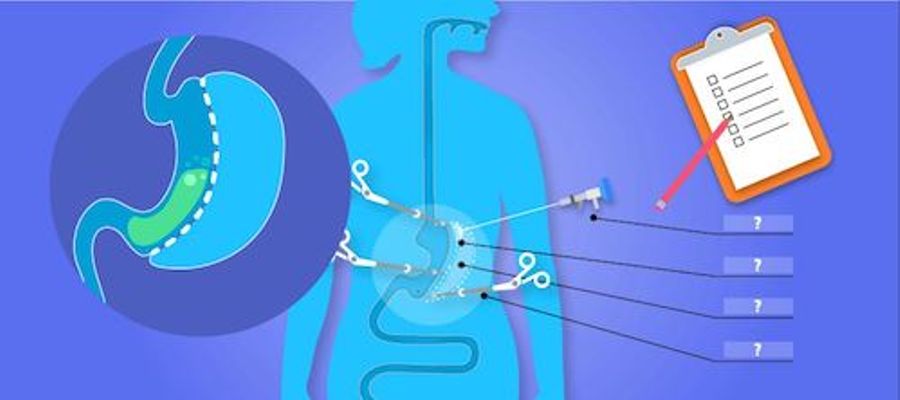The Endoscopic Sleeve Gastroplasty (ESG) is a weight loss procedure that reduces the size of your stomach. The reduction in stomach size is done using a specialized suturing pattern which leaves your entire stomach intact (other weight loss procedures require the surgical removal of a portion of your stomach). The ESG is also known as the “accordion procedure”, “scarless sleeve” or “Apollo Method.”
If you have the ESG, you will:
- Feel full sooner while eating, so you will eat less and lose weight
- Lose an average of 18% total body weight after two years
- Reduce your systolic blood pressure and improve overall health
Read the sections below for everything you need to know about Endoscopic Sleeve Gastroplasty.
TABLE OF CONTENTS
Click on any of the topics below to jump directly to that section
- How The Endoscopic Sleeve Gastroplasty Works
- Weight Loss
- Health Benefits
- How to Qualify
- Cost
- Recovery
- Diet and Life After
- Downsides
- Vs. Other Weight Loss Procedures
- Test Your Knowledge
- Find a Provider

SECTION SUMMARY:
- An endoscope with a camera and suturing device passes through your mouth and into your stomach
- Your doctor will use sutures to restructure your stomach, reducing the size of your stomach size by about 70%
- You will feel full sooner while eating, so you'll eat less and lose weight
- The ESG is non-surgical and less invasive than conventional bariatric surgeries
- The procedure takes less than 2 hours to complete
Why Endoscopic Sleeve Gastroplasty Works:
- Reduced stomach size makes the patient feel full sooner after eating
- Smaller stomach means fewer hunger-causing hormones are secreted, typically causing patients to feel less hungry
How Endoscopic Sleeve Gastroplasty Works:
An endoscope equipped with a suturing device is inserted into the patient’s mouth, down the esophagus, and into the stomach. This gives the doctor a full view to perform the procedure.
The doctor then sutures the stomach using specialized patterns to decrease stomach size. The goals of endoscopic sleeve gastroplasty are as follows:
- Reduce stomach size around 70%, reducing its capacity to hold food
- Shorten the length of the stomach between 30% and 50%
An Evolving Procedure
Endoscopic sleeve gastroplasty is an evolving weight loss treatment and best practice is not firmly established. Endoscopic doctors meet multiple times a year to discuss stomach folding, optimal locations for suturing, and effective suturing patterns to increase weight loss potential.
Ongoing research and investigation into effective methods will likely improve this procedure. Despite the ongoing research, it is currently recognized as an effective weight loss procedure with a strong safety record.
SECTION SUMMARY:
- Patients that have had the ESG lost, on average, 18.6% total body weight loss at their two year follow up
- For example, if you’re 5’ 4” and weigh 220 lbs, you will lose up to 15 lbs
- If you’re 5' 9” and weigh 300 lbs, you will lose up to 25 lbs
Studies on endoscopic sleeve gastroplasty suggest it is an effective weight loss option.
The most comprehensive study to date followed up with 215 patients two years after the procedure. Average total body weight loss was 18.6% (1). This means a patient who is 300 pounds should expect to lose around 55 pounds.
There has been limited research regarding long-term weight loss. Results in the table below are promising, but more data is needed to demonstrate long term weight loss efficacy.
| Participants | Total percentage of body weight lost | Timeframe | Year |
|---|---|---|---|
| 91 | 14%, 17.6%, 20.9% | 6, 12, 24 months | 2013 (5) |
All patients who undergo weight loss procedures need to make lifestyle changes. Patients who eat and exercise right are usually able to maintain weight loss, or lose even more. Patients who let their dedication slip may regain weight.
Successful patients avoid weight regain by:
- Working closely with a dietitian or nutritionist
- Using a personal trainer
- Attending in-person or online support groups at least twice per month
- Keeping a food journal
- Having the support of family and friends
- Maintaining motivation and dedication
See our Weight Gain After Bariatric Surgery page to learn more.

SECTION SUMMARY:
- You will improve your diabetes, hypertension, cholesterol issues, GERD, and bone/joint issues if you undergo the ESG to lose weight
- There are additional health benefits expected when more studies are released
There is limited research on the health benefits of endoscopic sleeve gastroplasty. So far, studies are pointing in a positive direction.
Studies have shown improvements in (6) (7):
- Diabetes
- Hypertension
- Hyperlipidemia
- GERD (Acid Reflux)
- Osteoarticular disorders (arthritis, musculoskeletal disease)
Endoscopic sleeve gastroplasty has not been linked to the following health conditions, but weight loss usually improves:
- Asthma
- Mood disorders (anxiety, depression)
- Cognition
- Sleep apnea
- Ashma
- COPD
- Orthopedic problems
- Acid reflux (GERD)
- Cardiovascular disease
See our Obesity Health Problems page for more information.
SECTION SUMMARY:
- You must have a body mass index (BMI) of at least 30 to qualify for the ESG
How to qualify for endoscopic sleeve gastroplasty will vary by doctor. Common requirements and guidelines include:
- Have a BMI above 30
- Have no previous weight loss surgery
- Do not have an eating disorder
- Diabetic patients must have blood sugar levels under control
- No history of stomach ulcers in the stomach or small intestines
- Have attempted weight-loss through diet and exercise without success
- A diagnosis of inflammatory bowel disease may be a disqualifier
SECTION SUMMARY:
- The average cost of the ESG is $12,000 and is not yet covered by medical insurance
The endoscopic sleeve gastroplasty cost ranges from $10,000 to $16,000. It is less expensive than procedures like gastric sleeve or gastric bypass because less overhead is required:
- No surgery
- Same-day release from hospital
- Less likely to result in costly complications
Is endoscopic sleeve gastroplasty covered by insurance?
Unfortunately, not yet. However, due to its excellent safety profile and a growing number of studies demonstrating weight loss efficacy, this may change. Talk with your surgeon to discuss what parts of treatment they can get covered.
Click Here to See How Much Others Procedures Cost
SECTION SUMMARY:
- Your pain and nausea will be managed using medication prescribed by your doctor
- It takes the average patient 1 to 3 days to fully recover from the procedure
Recovery from endoscopic sleeve gastroplasty is typically fast, and same day release from the hospital is standard. Patients often return to work within 24-48 hours following the procedure.
The endoscopic sleeve gastroplasty also has no exercise or lifting restrictions upon returning home, adding to its impressive recovery profile.
For more information, see our page on bariatric surgery recovery.
SECTION SUMMARY:
- You will be on a liquid diet for 2 weeks after the procedure (no solid foods)
- You will eat only semi-solid food for the next 2 weeks
- You will then transition to your long-term, regular diet of eating healthy, whole foods
- You will lose even more weight and improve your health if you exercise regularly
- Your personal relationships may change as a result of your weight loss
Weight loss after endoscopic sleeve gastroplasty is usually the focus, but it’s important to consider how your daily life will change. The procedure is only a tool and long-term success requires diligence and lifestyle change.
The following sections give you an idea about what to expect before and after the procedure.
Food And Drink, Your Diet Transition Schedule:
Endoscopic sleeve gastroplasty reviews indicate that the procedure is effective for weight loss, especially for patients who maintain a healthy diet. Building healthy habits around eating is just as important as the procedure itself.
Before the procedure, you may think, “You’re getting a weight loss procedure soon, so now’s the time to live it up!” You must have the complete opposite mentality. Unhealthy meals before surgery can increase your risk of complications.
Tap here to Review Your Diet Transition Schedule
| Timeframe Range | Diet Requirements |
|---|---|
| 2+ Weeks Before Surgery | Practice your post-procedure diet |
| 2 Weeks Before Surgery | High protein, low sugar, low carbs |
| 1 Week Before Surgery | Stop or change some medications |
| 2 Days Before Surgery | Clear liquids only |
| Midnight Before Surgery to 7 Days After Surgery (Varies by Surgeon) | Nothing to eat or drink |
| In Hospital (Varies by Surgeon) | Clear liquids only |
| Day 1 to Week 2 After Surgery (Varies by Surgeon) | Add thicker drinks & smooth foods (no chunks) |
| Day 2 to Week 3 After Surgery (Varies by Surgeon) | Slowly test pureed & soft solid foods |
| Day 3 to Weeks 4+ After Surgery (Varies by Surgeon) | Slowly test solid foods |
Pre surgery:
Prior to your endoscopic sleeve gastroplasty, the diet your doctor recommends will most likely be high-protein and low-carbohydrate with plenty of fluids. The night before the procedure, your doctor will likely require you consume no food or liquid after midnight.
After the procedure:
In order to allow your sutures to properly heal, avoid all carbonated beverages and solid food for the first month. Damaging the sutures may significantly impact your weight loss, lead to premature reversal of the procedure, or have unintended health consequences.
Around 4 hours after the procedure you can begin drinking low-sugar liquids. This may include water, broth, low sugar sports drinks, or iced tea. Patients remain on this low-sugar liquid diet for one to two weeks.
Two weeks later, semi-solid foods can be incorporated into your diet. Be mindful of what semi-solid entails and be sure to speak with your doctor if you’re unsure about specific foods. Here are some basic guidelines:
Examples of foods with a semi-solid consistency:
- Eggs
- Yogurt
- Cottage cheese
- Jello
- Canned fruit
- Soft fish
Ask your doctor about these foods:
- Meats
- Protein powder
- Potatoes
- Beans and legumes
- Fruits
- Vegetables
Avoid:
- Cereals
- Candy
- Fibrous vegetables (carrots, peppers, etc)
- Apples
- Pasta
- Bread
The semi-solid food diet will last for approximately two weeks depending on how you’re feeling. Your doctor will let you know when it is appropriate to transition. Foods that cause heartburn are not approved at this time.
See our page on bariatric eating to learn more about healthy eating habits for successful, long term weight loss.
Vitamins and Supplements: Not Required
The Endoscopic Sleeve Gastroplasty does not usually require patients to take additional vitamins or supplements. Because there is no resection or altering of the small bowel, there is little to no risk of malabsorption.
Exercise: 2.5 hours per week, spread out over 2 to 4 days
Exercise is almost as important as your diet when it comes to long-term success:
- Patients who exercise regularly lose more weight over the long-term
- Physical and mental health benefits are incredible
How much exercise do you need to for noticeable results?
One study of gastric bypass patients found that 2.5 hours per week resulted in 5.7% greater excess weight loss (8).To help you stay on track, block out time to exercise at the same times on the same days of the week.
Also, spread your 2.5 hours per week out over 3 or 4 days (in other words, 30 to 45 minutes 3 or 4 days per week). This will make it less intimidating to get started each day and will help you build endurance.
Exercise Types
There should be 3 main goals of your exercise routine:
- Endurance – walking, stationary bike, and especially swimming
- Flexibility – a good stretching routine. Yoga is best since it incorporates proper breathing and uses your own bodyweight to build strength
- Strength – exercise balls, weights, and yoga
For more information, see our page on exercise for bariatric surgery patients
Your Brain: Less Hungry, Careful About Food Addiction, Improved Cognition, New Mentality Will Change Behavior and Relationships
In addition to the many physical benefits following endoscopic sleeve gastroplasty, one important organ often goes overlooked: the brain. This organ consumes 20% of our energy and impacts our cognition, executive function, and moods. Endoscopic sleeve gastroplasty will affect how the brain works.
1. Cognition
Multiple studies suggest that obesity is linked to cognitive decline. Links to dementia, and an earlier onset of symptoms have been established (9). Other studies suggest that short term memory and attention deficits impair the population (10).
While there are varying theories as to why obesity contributes to cognitive issues, a popular school of thought suggests it is related to blood flow within the brain. Obesity is considered a risk factor for cerebrovascular disease (11), a condition where blood does not properly move throughout the brain. Dysregulated blood flow may cause a variety of issues including stroke and vascular dementia.
Fortunately, studies also indicate that weight loss procedures may improve cognition and brain health. In one study of patients, scores measuring cognitive function demonstrated improvement up to three years following surgery (12). Measured variables in the study included executive functioning, short term memory and attention span.
2. Hormone Regulation
When your stomach is empty, it secretes a hormone called ghrelin into your bloodstream. This causes your brain to generate hunger impulses.
After you eat, the amount of secreted ghrelin drops then slowly rises until your next meal. Since your stomach will be so much smaller after the endoscopic sleeve gastroplasty, the amount of ghrelin it secretes may also go down. Less ghrelin in your system means you will feel less hungry than you did before surgery.
See our page about Obesity & Genetics for more information.
3. Food Addiction
Our bodies secrete certain hormones (like ghrelin) that tell us when we’re hungry. Junk food may override those hormone signals by overstimulating our reward centers. This is just like the way our bodies and brains react to an addictive drug.
You may have food addiction if your desire for food takes priority over other important parts of your life, such as:
- Personal health
- Family
- Friends
- Work
- Your appearance
- Avoiding obesity related health issues like hypertension, sleep apnea, or diabetes
If left unchecked, food addiction can lead to obesity. If not addressed before surgery, it can also lead to weight regain.
To find out if you may be suffering from food addiction, take our Food Addiction Quiz.
4. Relationships
Being thin again, or being thin for the first time, may be a shocking experience. Many patients express amazement at:
- No more obesity discrimination. For example, strangers tend to be nicer to thin people.
- Being treated with more respect
- Getting more romantic interest from others
- Building deeper relationships by being able to physically keep up with kids and more physically fit friends
- Getting more compliments from others
- Increased self-confidence and the effect that has on others
- Improvements in quality of sexual life (13)
But there may be negatives to being thin as well. People who you’ve known for a long time will not be used to the way you look and may not know how to act around you. For example:
- How will overweight friends or family members feel when you’re losing weight but they are not?
- Will your new healthier diet and smaller portion sizes make meals with others awkward?
- Could intimacy with your spouse or partner be affected?
- Could your spouse or partner become jealous now that others are noticing you more?
- How will your coworkers react? Should you even tell them you are having surgery?
- Will your friends or family make it difficult for you to stay on track by making bad diet choices?
- Could your new self-confidence create conflict with people who are used the “old” you?
And what about the new “skinny lens” you see the world through? For example:
- Would this person be treating me the same way if I hadn’t lost all this weight?
- How do I handle obesity discrimination now that I’m on the “other side”?
Be prepared for both the good and the challenging “shocks” of dramatic weight loss following surgery.
For real life experiences and advice from other patients, see our Relationships After Weight Loss Surgery page.

SECTION SUMMARY:
- Early data shows almost 100% survival rate and a low risk of major adverse events, but more studies are needed to verify
- Partial openings of stomach pouch is possible
- Weight regain is possible
- Excess skin may occur after weight loss
The endoscopic sleeve gastroplasty has no known deaths directly related to the procedure. It does carry a risk of complications and side effects, but there appears to be less downside than other more invasive weight loss surgeries.
Safety
The most common endoscopic sleeve gastroplasty side effects include nausea and mild pain following the procedure. These symptoms typically subside within a few days and can be treated with pain and anti-nausea medication. Some patients report no side effects.
In some cases, more serious side effects occur. For example, in a Mayo Clinic study of 25 patients, three (12%) had serious adverse events that include a perigastric inflammatory collection, a pulmonary embolism, and a small pneumothorax. All patients fully recovered and no surgical treatments were required.
More studies on the short and long term effects of endoscopic sleeve gastroplasty are needed for a better safety profile.
Weight Regain
The prospect of regaining weight is a reality after all weight loss procedures, including endoscopic sleeve gastroplasty. Improper nutrition, overeating, and lack of exercise are all contributors to weight gain and stomach stretching even if you originally lost weight. If you’re unwilling to make a long term commitment to modifying your lifestyle, this procedure probably isn’t for you.
Fortunately, by following bariatric eating recommendations, you greatly improve the odds of maintaining weight loss.
For more information, see our page on weight gain after bariatric surgery.
Sagging Skin & Plastic Surgery
For many patients pursuing bariatric procedures, the skin has been stretched out for so long to accommodate their extra weight that it has lost its elasticity. Endoscopic sleeve gastroplasty causes many patients to lose a lot of weight very quickly, and your skin simply can’t keep up. The extra skin may be embarrassing. It can also cause several issues ranging from minor to severe, including:
- Difficulty getting dressed
- Difficulty exercising, which may impact long-term weight maintenance and health
- Skin fold rashes or breakdown of skin
- Skin fold infections
In some cases, patients manage sagging skin with body-contouring undergarments. In more serious cases, patients have plastic surgery to remove the excess skin. Surgery to remove excess skin is often covered by insurance.
See our page on Before and After Gastric Sleeve Surgery to see photos of patients who’ve undergone plastic surgery to remove excess skin.
SECTION SUMMARY:
- The ESG is non-surgical and "safer" than conventional bariatric surgery
- Your weight loss can be comparable or better than other weight loss surgeries
- There are similar health benefits to some of the "traditional" weight loss surgeries, but with less risk
A few facts stand out when comparing endoscopic sleeve gastroplasty to more invasive weight loss procedures like gastric sleeve, gastric bypass, duodenal switch, and LAP-BAND®.
- No incisions or scarring post surgery
- On average, patients are released faster from the hospital (typically same day)
- On average, patients return faster to work (24-48 hours)
- Lower risk of side effects
What’s the difference between the endoscopic sleeve gastroplasty and the popular gastric sleeve procedure?
The end result of endoscopic sleeve gastroplasty and gastric sleeve is similar; they both reduce the size of the stomach and make patients feel full sooner. But there are a few key differences patients should know about:
1. After the endoscopic sleeve gastroplasty, the patient’s entire stomach remains intact.
However, food is cut off from the majority of the stomach because the sutures block its movement. Just like gastric sleeve, patients feel full sooner after eating significantly less food because there is less space for food to go.
2. At any time following the procedure, your doctor can use an endoscopy to remove the sutures. In other words, the endoscopic sleeve gastroplasty is reversible and patients have the option to redo the procedure if the stomach stretches again. Gastric sleeve surgery cannot be reversed.
3. Studies are currently demonstrating that endoscopic sleeve gastroplasty results in slightly lower weight loss than gastric sleeve. While the reason for this is unknown, it may be related to procedural differences in removing part of the stomach vs. keeping part of your stomach unused. Future studies on this procedure may provide more insight into why gastric sleeve has a slight weight loss advantage.
4. While early weight loss results are promising, there is currently not enough data available to give definitive estimates. One small study of 25 reported that excess weight loss at 6 and 12 months was respectively 53% and 56%. More data is needed to compare this procedure against other established weight loss procedures.
Click Here to See Weight Loss By ProcedureMore comparisons (assuming longer-term studies prove out the existing limited research):
- Weight loss: Early studies indicate that endoscopic sleeve gastroplasty weight loss is comparable to gastric bypass and gastric sleeve after six months. It is much better than after LAP-BAND® surgery and gastric balloon.
- Hunger: Reduced hunger – only gastric sleeve and duodenal switch make you feel less hungry.
- Risks: Current evidence suggests long-term risk of endoscopic sleeve gastroplasty is lower than gastric bypass, duodenal switch, and LAP-BAND® surgery.
- External device: There is no external device left inside the body after endoscopic sleeve gastroplasty. Subsequently, there is no risk of device-related complications as there is with LAP-BAND®, gastric balloon, and AspireAssist. While the risk of device-related complications is relatively low for gastric balloon and AspireAssist, it is a concern and should be considered for LAP-BAND®.
- Compared to gastric bypass and duodenal switch (DS):
- Comparable improvement in obesity-related health problems
- Quicker recovery
- Complication rates are lower
- Risk of vitamin deficiency is lower
- Little to no risk of dumping syndrome (unlike gastric bypass)
- Side effects like nausea, vomiting, or diarrhea are less likely. If present, they are usually less severe than after gastric bypass.
- Without insurance, average cost for endoscopic sleeve gastroplasty is less than gastric bypass and DS
- Gastric bypass and DS are more likely to be covered by insurance if your policy includes bariatric surgery. Compared to LAP-BAND® surgery:
- Risk of long-term gastroesophageal reflux disease (GERD) is lower with endoscopic sleeve gastroplasty
- Risk of esophageal dilation, pouch dilation, and food trapping is lower with endoscopic sleeve gastroplasty
- No risk of external-device-related issues like LAP-BAND® erosion, band slippage, or port problems with LAP-BAND® surgery
- Much lower risk of long-term complications than LAP-BAND® surgery
- Fewer follow up doctor visits required than after LAP-BAND® surgery
- Average cost for LAP-BAND® surgery without insurance is on average 2,000 dollars more expensive
- LAP-BAND® is more likely to be covered by insurance if your policy includes bariatric surgery
For a more-detailed comparison of weight loss procedures, see our Types of Bariatric Surgery page.

SECTION SUMMARY:
- Click here to take the Endoscopic Sleeve Gastroplasty Quiz
Endoscopic Sleeve Gastroplasty: Test Your Knowledge

Well-educated patients are more likely to be successful over the long-term. Test your knowledge to ensure that you’re ready to take the next step!



